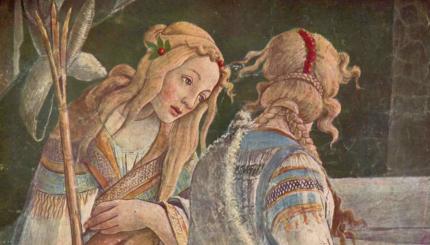Commentary on Parashat Mishpatim, Exodus 21:1-24:18
Parashat Mishpatim contains the ’s first law collection, which–unlike all other ancient Near-Eastern law collections–begins with regulations concerning slavery. The Torah seems unable to imagine an economy without slaves, but it frowns upon Hebrew slavery. Consequently, for Israelites in debt, Exodus 21:2-6 prescribes indentured servitude, but limited to six years. If a man enters debt-slavery while married, the master must let his wife go when he is released. However, if the master gives him a slave wife, the master retains the wife and children. What happens if the debt-slave declares, “I love my master and my wife and children: I do not wish to go free” (21:5)? He then has his earlobe pierced with an awl, and he becomes a slave in perpetuity, which the Rabbis interpret to mean until the Jubilee, or fiftieth, year.
Liberal readers are often sympathetic to this noble fellow who relinquishes his freedom to stay with his slave wife and children. But how would this case look from the perspective of the slave wife? I will argue that it looks much different. Who is this slave woman? She is not the amah ivriyah (Hebrew indentured servant) the text speaks about in 21:7-12. In that case, a girl has been sold by a presumably impoverished Israelite parent into a wealthier family on the understanding that she will eventually be married to the master or one of his sons as a free woman. This practice is well attested in other ancient Near Eastern documents. Should the man take another wife, he must continue to support her. An Israelite woman may not be resold if her owner is displeased with her; instead, she must go free without any compensation to the master. Her servitude, too, is time limited.
In contrast, the slave woman in Exodus 21:5-6 is most likely a foreign bondswoman. As a non-Israelite, she will not become part of the master’s family, and her slavery is perpetual, not limited. As property, she and a male Israelite slave can be mated by the master to breed more slaves, which cannot be done to an Israelite handmaiden. The foreign bondswoman does not choose her husband and cannot reject him. Both he and her children can be taken from her. As we learn from Exodus 21:20, 26-27, her very body is at risk, for masters may beat their own slaves without legal interference as long as they do not kill them or destroy a major body part. (Slave narratives from different parts of the world confirm that slaves were, and are, routinely battered and then expected to work. They may work less efficiently, but historically this has not been a sufficient disincentive to masters. The law cannot be said to permit battery of slaves; it is simply uninterested in such battery unless it results in major damage or death.)
Obtaining Freedom
While the Israelite slave must be freed at the start of the seventh year, how might the foreign bondswoman obtain her freedom? There are three options: First, she could save money given to her as a reward or a wage. If, with her owner’s permission, she contracts herself out for pay after finishing her other work, she might be able to accumulate money to buy her freedom. Mesopotamian records show that slaves were able to gain extra money as artisans and agents (see Gregory Chirichigno, Debt-Slavery in Israel and the Ancient Near East); this practice might have existed in ancient Israel as well. Second, she could run away. Deuteronomy 23:16-17 says that a fugitive slave may not be returned to the owner. Third, an Israelite slave husband once released could buy his slave wife and children and free them. African-American history shows examples of former slaves who bought spouses and children or arranged for them to be secretly stolen and led to freedom. Harriet Tubman, whose code name was “Moses,” had a long career of gathering slaves and leading them North. Implicit in these narratives is a desperate determination to be free.

Help us keep Jewish knowledge accessible to millions of people around the world.
Your donation to My Jewish Learning fuels endless journeys of Jewish discovery. With your help, My Jewish Learning can continue to provide nonstop opportunities for learning, connection and growth.
In contrast, what does the Israelite slave husband accomplish by pledging himself to perpetual slavery? When he declares that he loves his wife and children, it is not a happy, free family he is talking about. He cannot insure that his family will remain intact. His wife and children could be sold at any time. Even when his family is united, all will suffer the terrible humiliations of slavery: lack of choice, being objectified as property, being brutalized without recourse. Will the slave-wife appreciate his sinking into helplessness and hopelessness alongside her, especially if she was counting on his determination to free her once he was freed?
What Kind of Love is the Love for One’s Master?
When the debt-slave professes his love for his master (whom he mentions before his slave family in v. 5), what kind of love is this? It is a love of dependency, of not having to make decisions, of not having to struggle for a living, to choose a wife, or take responsibility for one’s children. Beyond that, embracing slavery undoes the liberation from Egypt and rejects the liberating God. In BT Kiddushin 22b, Rabbi Yochanan ben Zakkai explains why this man’s ear is pierced with an awl: “The Holy One says, ‘The ear that heard on Mount Sinai when I said, ‘the people of Israel are my servants and not servants of servants’ and went and got himself a human master, let that ear be pierced.”’
The bondswoman is not where she is because she volunteered to be a slave. Most likely, she is a captive taken in war, well schooled in the corrosive bitterness of slavery. She might see the Hebrew slave’s renunciation of freedom not as a romantic gesture, but as a naive, even stupid one. He has surrendered his power to free her or their children. He may have been her best chance for freedom.
The Torah is truthful with us, although that truth does not always make us happy. Ancient Near Eastern law could not imagine a world without slavery; yet Israelite law wanted the people to remain free of all human appropriation. That dilemma resulted in the preservation of this vignette about the conflicting loyalties of the Israelite slave. By highlighting the shadowy woman in the background, we get a rare, ironic glimpse of the dilemma from her usually invisible point of view.
Reprinted with permission from The Torah: A Women’s Commentary, edited by Tamara Cohn Eskenazi and Andrea L. Weiss (New York: URJ Press and Women of Reform Judaism, 2008).



